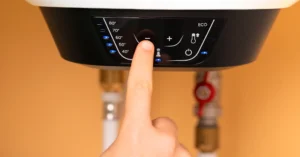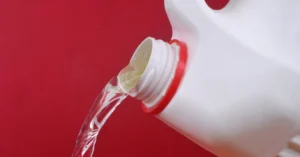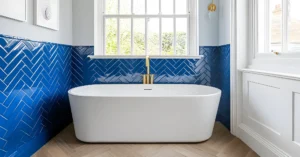The moment you discover you need a sewer line replacement can feel overwhelming. Beyond the immediate plumbing emergency, you’re likely concerned about your landscaping, hardscaping, and the potential disruption to your daily life. Fortunately, modern technology has created options that weren’t available to previous generations of homeowners.
At Solid Plumbing & Drain Inc., we’ve spent 20 years helping San Diego County homeowners navigate sewer line replacements using both traditional and trenchless methods. Our experience across thousands of properties has given us unique insight into which approach works best in different situations, particularly considering Southern California’s distinctive soil conditions, property layouts, and municipal requirements.
In this comprehensive guide, you’ll discover the key differences between trenchless and traditional sewer line replacement, the specific advantages and limitations of each method in San Diego’s environment, and how to determine which approach makes the most sense for your property and situation.
Understanding San Diego’s Unique Sewer Line Challenges
Before comparing replacement methods, it’s essential to understand the specific challenges that San Diego properties face regarding sewer systems.
Aging Infrastructure Throughout the County
San Diego’s housing stock spans multiple eras of development, each with its own sewer line characteristics. Our technicians regularly work with:
- Clay pipes in pre-1950s homes in neighborhoods like Mission Hills, North Park, and Kensington
- Cast iron pipes in mid-century developments throughout Clairemont, Allied Gardens, and La Mesa
- Orangeburg pipes (compressed wood fiber and coal tar) in some 1945-1972 homes
- Early plastic pipes in 1970s-1980s developments that are now reaching end-of-life
- Modern PVC and ABS systems in newer communities
This diverse infrastructure creates neighborhood-specific challenges, as different materials fail in different ways and respond differently to various replacement techniques.
Soil Composition and Seismic Considerations
San Diego County features remarkably diverse soil conditions that significantly impact sewer line performance and replacement options:
- Expansive clay soils in areas like Mira Mesa and Rancho Peñasquitos that shift seasonally with moisture changes
- Sandy coastal soils in beach communities from Oceanside to Imperial Beach
- Rocky conditions in foothill areas like Del Cerro and San Carlos
- Fill soils in developed areas like Mission Valley that may settle unevenly
- Varied geological formations created by the county’s numerous fault lines
These soil conditions not only contribute to pipe failures but also influence which replacement method might be most appropriate and durable for specific properties.
Landscape and Hardscape Investments
San Diego homeowners typically make significant investments in outdoor living spaces, creating additional considerations for sewer work:
- Mature landscaping that may have taken decades to establish
- Expensive hardscaping including patios, walkways, and driveways
- Swimming pools and water features that may sit above sewer line paths
- Outdoor kitchens and living areas that have become extensions of the home
- Drought-resistant landscaping that required substantial investment
The potential impact on these valuable property features often becomes a primary concern when homeowners face sewer line replacement decisions.
Traditional Sewer Line Replacement: The Conventional Approach
For decades, the only option for replacing failing sewer lines involved extensive excavation. Let’s examine how this approach works and its implications for San Diego properties.
How Traditional Replacement Works
The conventional method follows a straightforward but labor-intensive process:
- Excavation of a trench along the entire length of the sewer line, typically 3-8 feet deep depending on the pipe depth
- Removal of the old, damaged pipe section by section
- Installation of new pipe, usually PVC or ABS plastic
- Connection to the home’s plumbing system and the municipal sewer main
- Inspection and testing of the new line
- Backfilling the trench and basic restoration of the excavated area
This approach provides direct access to the entire sewer line, allowing for complete removal of the old system and visual confirmation of the new installation.
Advantages of Traditional Methods for San Diego Properties
Despite being more invasive, traditional replacement offers several benefits that make it appropriate in specific situations:
- Complete removal of old pipes, eliminating any potential issues with deteriorating materials left in place
- Visual inspection of the soil conditions surrounding the pipe, revealing any additional problems that might affect the new installation
- Rocky conditions in foothill areas like Del Cerro and San Carlos
- Ability to make significant changes to the pipe path, slope, or diameter if needed
- Often simpler permitting process with San Diego County and city municipalities
- Typically lower equipment costs, which can translate to savings for straightforward installations
For certain properties, particularly those with complex layout issues or where complete system redesign is needed, traditional methods remain the most appropriate choice.
Disadvantages and Disruption Factors
The drawbacks of traditional replacement are significant, especially in San Diego’s high-value residential areas:
- Extensive disruption to landscaping, potentially destroying mature plants and trees that thrive in our climate
- Damage to hardscaping including patios, walkways, driveways, and other expensive features
- Longer project duration, typically 3-7 days for a standard residential replacement
- Greater labor costs due to the extensive excavation and restoration work
- Potential for additional complications if unexpected utility lines or geological features are encountered
These factors make traditional replacement particularly challenging in established San Diego neighborhoods with mature landscaping and extensive outdoor improvements.
Trenchless Sewer Line Replacement: Modern Alternatives
Trenchless technology has revolutionized sewer line replacement, offering methods that minimize disruption while providing durable results. Let’s explore the primary trenchless options available to San Diego homeowners.
Pipe Lining (Cured-In-Place Pipe)
Pipe lining creates a new pipe within your existing sewer line without extensive excavation:
- A flexible tube coated with special resin is inserted into the existing pipe
- The liner is inflated, pressing against the interior walls of the old pipe
- The resin cures (either naturally or accelerated with heat or UV light), creating a new, seamless pipe within the old one
- Robotic cutters reopen any branch line connections
- The new liner provides a smooth, durable surface with an expected lifespan of 50+ years
This method requires only small access points rather than a continuous trench, dramatically reducing disruption to your property.
Pipe Bursting Technology
Pipe bursting replaces the existing pipe while minimizing surface disruption:
- Access pits are dug at the beginning and end of the section being replaced
- A bursting head is pulled through the old pipe, breaking it outward into the surrounding soil
- A new pipe is simultaneously pulled into place behind the bursting head
- The new pipe follows the exact path of the old one but can be the same size or larger
- The access points are restored after installation is complete
This method is particularly valuable when the existing pipe has collapsed or has significant structural damage that makes lining impractical.
Advantages of Trenchless Methods in San Diego’s Environment
Trenchless approaches offer compelling benefits that address many San Diego-specific concerns:
- Preservation of landscaping, particularly important for established properties with drought-resistant plants that took years to mature
- Minimal disruption to hardscaping, saving expensive restoration costs for patios, driveways, and decorative concrete
- Shorter project duration, typically 1-2 days for standard residential installations
- Reduced labor costs despite higher equipment expenses
- Less soil disruption, which can be significant in hillside properties common throughout San Diego County
These advantages have made trenchless methods increasingly popular throughout the region, particularly in high-value coastal communities and established neighborhoods with significant landscape investments.
Limitations and Considerations
Despite their benefits, trenchless methods aren’t appropriate for every situation:
- Pipe lining slightly reduces the internal diameter of the pipe, which may be problematic if the original pipe was already undersized
- Certain types of damage or pipe configurations may make trenchless approaches technically unfeasible
- Some older San Diego neighborhoods have unusual sewer configurations that complicate trenchless installations
- Complete pipe collapse or extensive root intrusion may require traditional excavation in some sections
- Proper cleaning and preparation of the existing pipe is essential for successful trenchless installation
Professional assessment is crucial to determine whether trenchless methods are viable for your specific situation.
Cost Comparison for San Diego Homeowners
Understanding the true costs of each approach requires looking beyond just the initial price quote.
Initial Installation Costs
The upfront pricing structure differs significantly between methods:
- Traditional replacement in San Diego typically ranges from $15,000-$30,000 for a standard residential installation, depending on length, depth, and surface restoration requirements
- Pipe lining generally costs $10,000-$20,000 for similar applications, with variables including pipe diameter, length, and number of branch connections
- Pipe bursting usually falls between $12,000-$25,000, influenced by soil conditions, pipe depth, and access challenges
While trenchless methods typically have higher equipment and technology costs, they often result in lower total project costs due to reduced labor and restoration expenses.
Hidden Costs and Long-term Considerations
The full financial picture includes several factors beyond the base installation price:
- Landscape restoration after traditional replacement can add $2,000-$10,000 depending on the property’s features
- Hardscape repair or replacement costs for driveways, walkways, and patios can exceed $5,000-$15,000 for properties with extensive improvements
- Lost property use during longer traditional projects may impact home-based businesses or rental properties
- Potential water damage risks from extended open excavation during San Diego’s occasional but intense rain events
- Long-term property value impacts from landscape changes, particularly for mature trees that cannot be easily replaced
When these factors are considered, trenchless methods often provide better overall value despite sometimes higher initial quotes.
Financing and Return on Investment
The financial decision extends beyond immediate costs:
- Many San Diego homeowners find that home equity financing makes larger upfront investments in trenchless technology manageable
- Property value protection by preserving mature landscaping represents significant value, particularly in premium neighborhoods
- Insurance considerations may favor methods that minimize risk of collateral damage
- Future sale value benefits from having documentation of complete sewer replacement using modern methods
- Water bill savings from improved flow characteristics in modern pipe materials
These long-term financial factors often make trenchless methods the more economical choice when viewed comprehensively.
Decision Factors: Which Method Is Right for Your San Diego Property?
Several key considerations should guide your decision between traditional and trenchless sewer line replacement.
Property-Specific Considerations
Your property’s unique characteristics significantly impact which method makes more sense:
- Age and material of existing sewer line (certain materials respond better to specific replacement techniques)
- Depth of the existing pipe (deeper lines increase the advantage of trenchless methods)
- Presence of mature trees and root systems (particularly relevant in established San Diego neighborhoods)
- Value and age of landscaping and hardscaping features
- Slope and terrain challenges common in San Diego’s varied topography
- Proximity to property lines and neighboring structures
Professional assessment of these factors helps determine the most appropriate approach for your specific situation.
Pipe Condition and Damage Assessment
The extent and nature of the existing damage heavily influences method selection:
- Pipes with numerous small cracks but still maintaining their shape are excellent candidates for pipe lining
- Collapsed sections or pipes with significant deformation typically require pipe bursting or traditional replacement
- Offset joints beyond certain tolerances may complicate trenchless approaches
- Extensive root intrusion may require specialized preparation before trenchless methods can be employed
- Changes needed in pipe diameter or path may necessitate traditional excavation
Modern video inspection technology allows for precise assessment of these conditions before making replacement decisions.
Timeline and Disruption Tolerance
Your personal circumstances and property use affect which approach best meets your needs:
- Urgent replacement needs during rainy season may favor faster trenchless methods
- Properties used for vacation rentals benefit from the shorter disruption of trenchless approaches
- Homes with limited alternative access points may find traditional trenching particularly problematic
- Properties preparing for sale may prioritize methods that minimize visible landscape impact
- Homeowners planning other major renovations might coordinate traditional replacement with other excavation work
These practical considerations often prove decisive when technical factors don’t clearly favor one method over another.
Neighborhood-Specific Insights for San Diego County
Our extensive experience throughout San Diego County has revealed patterns in which replacement methods tend to work best in specific areas.
Coastal Communities
For properties in coastal communities from Oceanside to Imperial Beach:
- Sandy soils often make excavation more complicated and expensive, favoring trenchless methods
- Higher property values typically justify the investment in less disruptive approaches
- Salt air exposure accelerates deterioration of certain pipe materials, influencing replacement choices
- Water table issues in some areas can complicate traditional excavation
- Premium landscaping common in these areas represents significant value to preserve
In communities like La Jolla, Del Mar, and Coronado, we’ve found trenchless methods are selected in approximately 80% of replacements due to these factors.
Older Urban Neighborhoods
These neighborhoods typically see a mix of methods employed, with decisions heavily influenced by specific property layout and preservation needs. While some older homes require traditional excavation to fully remove collapsed clay or Orangeburg piping, others can benefit from pipe lining or pipe bursting if the structure is intact. Homeowners in these areas often prioritize trenchless methods to preserve historic landscaping, mature trees, and original architectural features.
Inland Communities and Foothill Neighborhoods
Areas such as Scripps Ranch, Rancho Peñasquitos, Poway, and El Cajon present unique challenges:
- Expansive clay soils lead to pipe movement and joint separation
- Hillside properties often feature deep sewer lines that increase excavation complexity
- Larger lot sizes may allow more flexible trench access, but restoration costs still add up
- Older developments frequently have mixed pipe materials due to phased expansions
- Trenchless methods are frequently chosen to minimize slope disruption and avoid erosion risks
Our team has found that pipe bursting and lining are often the most cost-effective and least disruptive solutions in these inland communities, especially where depth and access are concerns.
Newer Developments and Planned Communities
Neighborhoods such as Carmel Valley, Eastlake, Otay Ranch, and 4S Ranch often feature newer infrastructure and uniform construction:
- PVC or ABS piping is common, but early installations may now be aging
- Homes often include advanced landscaping or custom concrete work
- Easement access and HOA considerations sometimes restrict excavation
- Trenchless methods are often viable and favored for speed and minimal impact
In these areas, pipe lining is frequently selected when pipes are structurally sound, while pipe bursting provides a full replacement option without excavation damage.
Final Thoughts: Protect Your Property with the Right Sewer Solution
Choosing the right sewer line replacement method isn’t just about fixing a pipe—it’s about protecting your home, preserving your investment, and planning for the future. In San Diego’s diverse housing landscape, the best solution depends on your location, your property’s features, and the specific condition of your sewer line.
At Solid Plumbing & Drains Inc., we bring deep local experience to every evaluation. We don’t just install—we educate, recommend, and guide you through every step, so you can make an informed decision with confidence.
Schedule your sewer line consultation today




